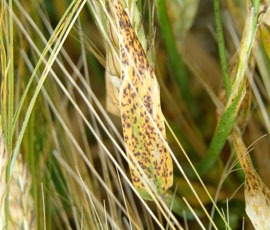Ramularia risk higher this season across the UK

Winter barley crops are at a higher risk from ramularia this year following rainfall across most of the country at the beginning of April, warns the SAC.
Research into the disease has shown a strong correlation between leaf wetness in late spring and the severity of the disease that develops, explains SAC’s Fiona Burnett, who adds that the findings have been used to develop a risk warning system.
“Leaf wetness at the start of April is the key time for the winter crop, while early June is the critical stage for the spring crop. These dates relate to the first node stage in winter and spring barley respectively.”
The SAC system is based on minutes of leaf wetness measured at the organisation’s trials sites in Scotland, she reports. “But this increased risk is relevant for the whole of the UK this year, due to the cold nights and greater amount of rainfall when compared with the same two weeks in 2011.”
Her colleague, Neil Havis, who found the link between leaf wetness and disease severity, says that rainfall is only part of the story.
“Cold nights and mornings where dew lingers in the crop are just as important,” he stresses.
Low temperatures allow ramularia to colonise the crop, before it can grow away from infection, he adds. “That’s because the disease is seed-borne and present in very young plants. A period of leaf wetness means it can spread to the upper leaves.”
Classic brown spotting and extensive loss of green leaf area follows and symptoms are made worse by any stress to the crop, notes Dr Havis. “That’s why they tend to appear after flowering.”
Some fungicides can make the symptoms worse, he warns, as they also stress the crop. “There’s a negative impact of hotter chemicals, such as the morpholines. So it’s best to do your mildew control at T1.”
This is because ramularia in the leaf isn’t a particular problem until it starts to produce toxins, which it does when overcrowded or stressed. “The toxins allow it to break out of the leaf and spread to new hosts, and the hotter fungicides seem to act as a trigger for this process to begin.”
SAC advice, on the basis of the increased ramularia risk, is to protect crops at T2 with fungicides based on either prothioconazole or SDHI chemistry, or a mixture of both.
“Ramularia activity is a particular feature of the SDHIs, so they have a good position at T2 on winter barley,” continues Dr Burnett.
SDHI options include 0.6 litres/ha of Siltra Xpro, 1 litre/ha of Adexar, 1.2 litre/ha of Bontima or 1 litre/ha of Tracker, she summarises.
“Chlorothalonil is still an important component of the T2 treatment in most situations, but if you know that you need high levels of eradication, it may be best to leave it out as it can reduce kickback.”
Her preference is to keep Tracker for the cleaner crops, as it is not as strong on other foliar diseases as the newer SDHIs.
“Prothioconazole-based products are also good choices. Fandango at 0.75 litres/ha or Proline 275 at 0.35 litres/ha, both with 1 litre/ha of chlorothalonil, will also give ramularia protection.”
SAC will be issuing a ramularia risk prediction for spring barley crops at the start of June.
Actives
• Adexar – epoxiconazole + fluxapyroxad
• Bontima – cyprodinil + Isopyrazam
• Fandango – fluoxastrobin + prothioconazole
• Siltra Xpro – bixafen and prothioconazole
• Tracker – boscalid + epoxiconazole

